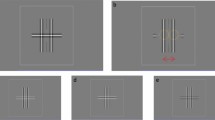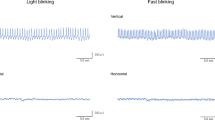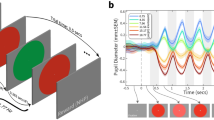Abstract
DURING the act of blinking the pupils are masked by the upper lids for an appreciable fraction of a second (c. 0·1–0·3 sec.) and, in consequence, vision is intermittent. The blackout index expresses the percentage of vision during which one is unsighted, and is obtained from the ratio of the blackout and interblink periods, the normal average value of the latter being for men and women c. 3·3 sec. In conversation, the average interblink period is only c. 2.7 sec.1.
This is a preview of subscription content, access via your institution
Access options
Subscribe to this journal
Receive 51 print issues and online access
$199.00 per year
only $3.90 per issue
Buy this article
- Purchase on Springer Link
- Instant access to full article PDF
Prices may be subject to local taxes which are calculated during checkout
Similar content being viewed by others
References
Hall, Sir Arthur, Brit. J. Ophthal., 29, 446 (1945).
Lawson, R. W., Nature, 161, 154 (1948).
Lord, Mary P., and Wright, W. D., Nature, 162, 25 (1948).
Author information
Authors and Affiliations
Rights and permissions
About this article
Cite this article
LAWSON, R. Photographic Evaluation of Blackout Indices. Nature 162, 531–532 (1948). https://doi.org/10.1038/162531a0
Issue Date:
DOI: https://doi.org/10.1038/162531a0
Comments
By submitting a comment you agree to abide by our Terms and Community Guidelines. If you find something abusive or that does not comply with our terms or guidelines please flag it as inappropriate.



